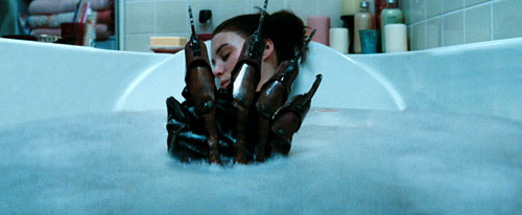Weekend Wrap-Up for April 30 - May 2, 2010
Michael Bay Profiteering Dominates Iron Man 2 Lead Up
By John Hamann
May 2, 2010
Same old, same old. It's another Nightmare on Elm Street, and obviously there are a lot of people out there who are thrilled at the news that their favorite horror franchise is back. It seems that nothing has changed much in Freddy Krueger Land, save for Jackie Earl Haley replacing Robert Englund, as the movie making is bad, and the audience voracious – at least for a weekend. With Iron Man 2 showing up next Friday, it was a smart scheduling move to park an idiotic horror flick behind the Metal Crusader, as you don't have to be a rocket scientist to figure out that Freddy Krueger is really only here for one weekend.
In 1984, Wes Craven made a new horror movie called A Nightmare on Elm Street. It resonated extremely well with critics and audiences, and created a franchise that put out seven very successful films over ten years. Nightmare on Elm Street was, at the time, produced and distributed by the new studio on the block, upstart New Line Cinema, and it was only their second film to be released, after 1983's Evil Dead. The studio spent $1.8 million producing the film, and it launched November 9, 1984 to $1.3 million from only 165 screens. It garnered a venue average of $7,705 – which meant this new studio was going to have a decent sized hit. Nightmare outgrossed its opening over the next two weekends, and went on to earn $25.5 million (a decent amount for 1984). The second film in the series – Freddy's Revenge – was released exactly one year later - without Wes Craven – and opened to $2.9 million against a production budget of $3 million. It finished with $21.2 million. The next three films in the series came out in concurrent years – 1987, 1988, and 1989, and New Line spent a combined $24 million to make them. The return on investment was huge, as these three films earned $116.3 million at the domestic box office. The sixth film, The Final Nightmare, was its biggest opener at $13 million, but not its biggest finisher, as it closed at $34.9 million, but against a budget of only $5 million. The shine was starting to come off. In 1994, Wes Craven came back to do Wes Craven's New Nightmare, but the franchise was stale and tired. It opened to $6.66 million (natch), but finished with only $18.1 million. In 2003, Freddy came back to fight Jason Voorhees, but that really wasn't a part of this franchise, and should be seen by no one. New Line Cinema, or The House That Freddy Built, went on to release some huge films, like the Lord of the Rings series, and it was all thanks to Wes Craven, and the guy that claws through your nightmares.
With that kind of pedigree, one might think Warner Bros. and Platinum Dunes (Michael Bay's production company – yes, that Michael Bay) would put as much effort as possible into rebooting what once was a beloved franchise. Instead of doing that, they spent $35 million on the project, hired an unknown director, and refused to include Wes Craven or Robert Englund in the process. The result is a boring mess, but audiences still came out because they know the character (it's easier if we don't have to think). The reboot of A Nightmare on Elm Street earned $32.2 million this weekend, after being released to 3,332 venues (the highest cost on the picture was almost certainly prints and advertising). It had a venue average of $9,664. One thing the filmmakers were able to keep the same was making serious money. This Nightmare cost $35 million to make, so after next weekend's grosses are counted (Iron Man 2 or not) this one is going to make a profit.
Continued:
1
2
3
|
|
|
|




